Best of Reaktor User Library september 2.015
Blocks > Patches
Arpon
by Sergio Durán Toledano
Dos Osciladores son animados por un secuenciador de 8 pasos que a su vez es modificado por un segundo secuenciador que define la nota raiz del arpegio. Los dos osciladores tienen rutas individuales.
Como fuente de modulacion A estan las envolventes y los LFO dependiendo del modulo y como fuente de modulacion B casi siempre es la Velocidad de las notas del primer secuenciador.
***
Blocks Auto Filter
by Phil Durrant
Blocks Filter modulated by an Envelope Follower and Synced LFO
Inspired by Ableton Live's 'Auto Filter' The idea behind this is to have an effect where an Envelope Follower and LFO can modulate a Filter.
The main inputs are for the sound that is going to be filtered - a typical use would be a pad sound.
Inputs 3 and 4 are for a Sidechain input - -typically a kick sdrum sound. These inputs are summed and sent to the Envelope Follower.
The Envelope Follower's output has been connected to the Mod A input of the SVF Filters.
Two filters had to be used to make this a stereo device. The controls of the 'Master' filter also control the controls of the 'Slave' using the To/From Connect feature.
LFO Synced - by Mete Atam - is connected to Mod B of the filters.
***
Blocks MC-202 Synth
by Phil Durrant
Blocks emulation of the MC-202 Synth: with Maschine Presets
This is a Block emulation of Roland's MC-202 Synth, but with elements of their SH-101 as well.
One of the special things about the 202 is the ability to delay the onset of the LFO. This delay is achieved by an ADSR Decay - labeled ‘Decay-> SLEW’, modulating the SLEW in a CVP - labeled ‘CVP for LFO Delay’.The LFO and Delay settings are on the second row of Blocks.
Much of the top row tries to emulate the settings of the MC-202:
MOD Pitch - just labeled MOD on the 202 - the 'Level' knob controls how much the LFO Modulates the pitch.
PW Manual - labeled Pulse Width on the 202 - the 'Level' knob modulates the Pulse Width amount. I have used the system on the 202 where switches switch between LFO, MAN, and ENV as the modulation sources. These are selected by the Switch V1 in the second row. This was made by Jason Leiter
The Multiwave OSC is ideal as it has a Pulse, Saw and Sub just like the 202. In addition the Noise emulates the SH-101.
The Filter can be modulated on the original 202 by ENV, MDO, and KYB. On the Blocks version they are labeled ENV, MOD FILT and KYBD. As before, I have used the 'Level' knobs from a CVP to control how much modulation is going to the filter
Unlike the MC-202 or SH-101 there are seaprate ADSRs for Amplitude modulation and a second one which behaves like the original ADSR.
The folder includes some 'Preset Mapping' nrkt files that can be used in Maschine 2.3.1 and Komplete Kontrol 1.2.0. Put them in your 'User Content' folders and rescan this folder in your Preferences in Maschine and Komplete Kontrol. The reason I used the CVPs is because their Level knobs can be automated, and so they are ideal to use as ‘Modulation Amount’ controls for live tweaking but also sound design.
***
Blocks Trance Gate Clock Divider
by Phil Durrant
Trance Gate with Filter/LFO/Delay and 2 triggered ADSRs
Only the first 2 Gate outputs from the CLK DIV are in use. The first one is triggering an ADSR for the VCA and the second one, triggers a second ADSR that triggers the filters.
Like my last upload, the Left SVF Filter is the 'Master' and the Right SVF Filter, is the slave. Please note you can still change the parameters of the 'Slave' to have independent control!
An LFO can also modulate the filters. With independent control over the filter settings, some filtered panning can be achieved.
Two CVP's have been used as controls for Env Amount and LFO Amount. That means it is easy to do live tweaking and also record this as automation without additional programming. To clarify, by default, the Mod A and Mod B settings in the filters do not have Automation IDs.
The Rounds Delay has been added to spice up the rhythms.
The Clock Dividers provide a quick way of changing rhythms and also have the possibility of setting 3 against 4, etc, etc between the Amplitude modulation and filter modulation.
***
Chord Machine
by Jason Leiter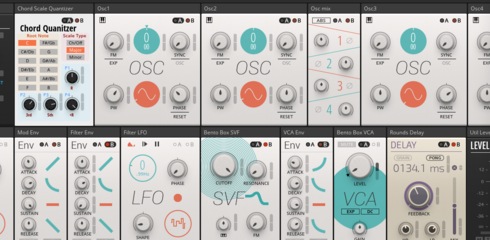
Just a little ensemble to show the usage of my chord quantizer. There's a few snaps in there.
The chord quantizer is here http://www.native-instruments.com/en/community/reaktor-user-library/entry/show/8757/
***
DelayBlocks-001
by John Squibb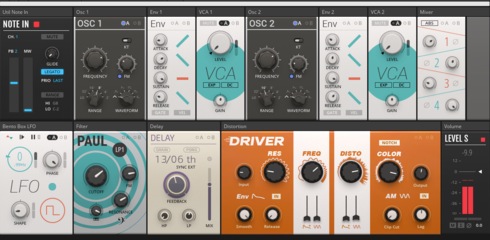
2 OSC's w/ dedicated ADSR/VCA + LFO, Filter,Delay,Distortion
A basic blocks synth with MIDI input to two oscillators each with their own dedicated ADSR/VCA. The oscillators are passed into the first two channels of a 4-channel mixer. Osc 1 & 2 are also run directly into channels 3 and 4, bypassing the envelope and amp, allowing the synth to run without MIDI and to allow for some strange noise/delay experiments. The mixer output is passed on to filter, distortion, then finally the delay. A single LFO can be used to modulate the oscillators and filter, and is configured for use with mod wheel (Mod A).
Includes 16 Presets in Bank 1 to get you started.
***
Disperse 5
by Jim Hurley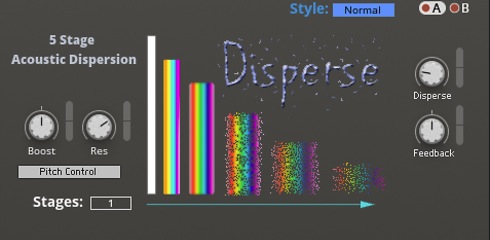
Acoustic Dispersion effect
Dispersion is a property of sound in inelastic media such as water or metal. It is the principle used by SONAR™ and medical acoustic imaging.
This has been realized by using a multi-band filter with a delay line on each band. A peaking equalizer at the center frequency of each band is attuned to the MIDI note/Pitch being played. The delays are set to follow a dispersion coefficient that is proportional to the square root of the frequency. The best results are when several stages follow in sequence imitating the dispersion of sound through a medium. You may also add feedback to each delay.
This Block was built as a learning experience in converting a Primary ensemble to Core and into the Blocks paradigm. I could not have done it without help from Mark Wadewitz and Herwig Kraß.
You can think of this as putting your ear on a long thick cable and listening to the sound of it being struck at various distances from you. Each stage moves you farther from the source and more of the spectrum gets 'smeared'. Whereas a filter removes frequencies, dispersion delays them at varying rates.
Along with the "EFX-Disperse 5" Block, I put in a very simple Block Patch ensemble (a simple sequencer) that you can use to get familiar with it's properties.
I find it sometimes useful to mix a delayed copy of the input back into the dispersed output to time-align the two effects. You can use the Rounds delay in the patch to see that. The Pulsifier Block will narrow the waveform of anything so that it may be used as an impulse into the dispersion effect.
Several simple ensemble and Block snapshots are there to show the staging CPU impact, and some more exotic effects.
The 'Stages' number is the number of banks to use. Each bank has 9 octave band filters and delay lines. Each bank feeds the next bank. Unused banks are not clocked.
The 'Style' parameter is the type of dispersion. 'Normal' is set to have the delays and feedbacks decrease with frequency as in nature. The other settings are artificial, but useful.
The default knob settings will enable the typical dispersion heard in normal types of material. It is possible to self-oscillate with too much feedback and other settings, but there are limiters which should protect your ears and speakers. Nevertheless, use caution with extreme feedback, boosts and resonances.
This is a low-CPU version (with 5 stages of dispersion) of my Disperse Block (which has 10 stages of dispersion) for fast CPUs.
***
Echo PR1
by SFR Project rizla+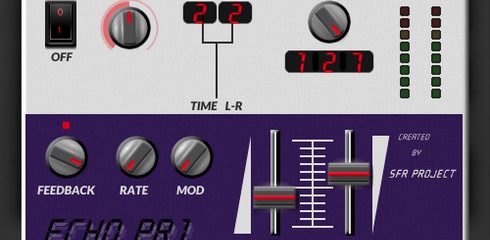
ECHO PR1 Module echo-delay Created By SFR Project
***
Knuertznankel
by Dieter Zobel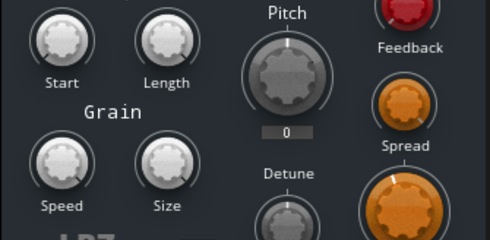
micro looper,
Haben Sie Bitte Spass.
***
Lizard's Logic
by Jan Ola Korte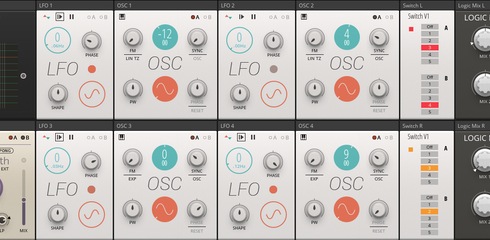
Drone machine using the first Blocks added by users!
A drone machine - four Bento Box VCOs with a touch of sync and FM are fed into two instances of Michael Hetrick's 'Logic Mix', creating beatings and lively disturbances with a wide stereo effect.
Jason Leiter's 'Simple Switch' is used to allow for different modulation sources being assigned to the 'Logic Mix' Blocks in each Snapshot:
Switch L (selects modulation sources for left channel 'Logic Mix')
1 - OSC 3
2 - OSC 4
3 - LFO 1
4 - LFO 2
Switch R (selects modulation sources for right channel 'Logic Mix')
1 - OSC 3
2 - OSC 4
3 - LFO 3
4 - LFO 4
Visual support by Jan Brähler's 'Filter Bank Spectrometer'.
Sounds best when played in a range from C2 - C4.
***
On The Run Patch
by Matt Cellitti
Just a classic patch - shows off a few ways to utilize some of the key Blocks. Obviously it gets way more fun when you MIDI map a few parameters and start turning knobs on your controllers.
***
Reaktor 6 Spits
by ross healy
random experimental tek https://www.youtube.com/watch?v=1zA0ZloYE9I
***
Rhythm Maker
by John Squibb
Blend and Sequence Oscillators to create rhythmic patterns
* Dual Oscillators blended using crossfader (X-Fade).
* Control the mix using knob adjustment, or LFO modulation (Mod A).
* Scope displays visual of blended result.
* 8-step sequencer with clock and divider.
* Delay for adding a little bit of flavor.
8 presets to give an idea of functionality. More presets to come.
Implements the Crossfade block from ADSR tutorial series, check it out here:
https://youtu.be/EbZH80EJzIc?list=PLlsEknwQnAoQpRvvBvNZmyR_rya-bspC4
***
SchepperVerb III
by Dieter Zobel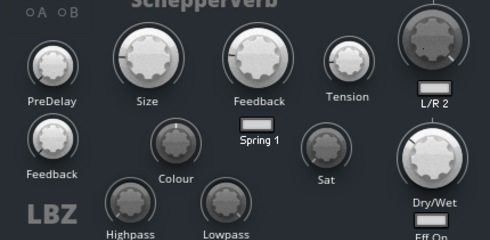
Reverb effect
***
Simple Fx adds
by Giovanni Ghisleni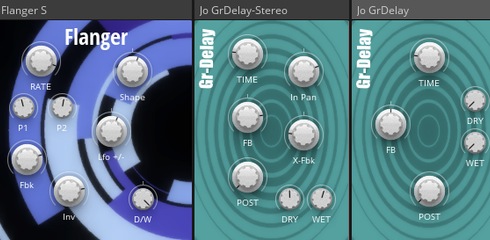
Here's another test, grain delay ( mono and stereo ) and a Flanger.
***
Simple Osc and a panner
by Giovanni Ghisleni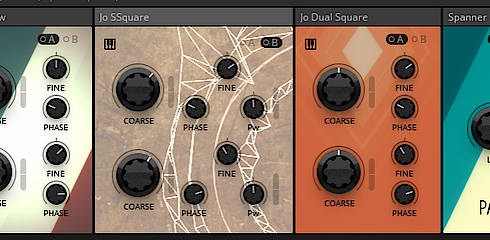
The ens contains two super osc ( saw and square* ) and a simple panner.
I made the block as test and sure can be done better ;)
hope u like!
1.1 now with pw for the square
***
Blocks Templates
Blocks - Building Template
by Native Instruments
Reaktor 6 introduces Blocks — a self contained system that brings the patching experience of analogue modular synthesizers to Reakor.
The Blocks Building Template provides you with all the essential elements to get started building your own Blocks. Including template instruments, panel widgets, core macros, and documentation.
***
Effects
8Delay
by kent williams
Tempo-Synced Multitap Delay Effect with chaotic signal path
At it's core, 8 tempo-synced delays. This network is fed by the input signal, plus feedback from the output. The feedback is distributed to one or more of the delays, under the control of an LFO.
An LFO also controls which of the delays provides the output.
The result is a chaotic delay signal that changes constantly but stays synced rhythmically to the project tempo.
***
Core Disperser
by Jim Hurley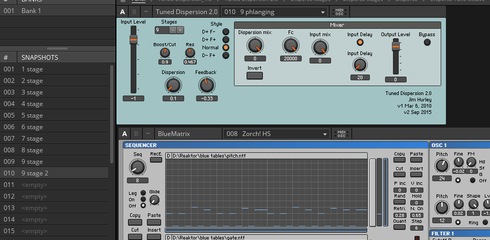
Acoustic Dispersion effect
This is almost the same Core Cell used in the Blocks version of "Disperse", but it is housed in a standard Reaktor ensemble, not a Block. The Blocks version has one more stage added (10), this has 9.
It uses a bit less CPU and may be useful for those with less powerful CPUs.
This version is not very polished since I used it as a test-bed for the Blocks macros, nevertheless it is fully-functional and should be fun.
I used the Blue Matrix factory sequencer in the testing, so I included it and the test snapshots.
***
Synthesizers
AmpDrum 1.4
by Matthias Schaffner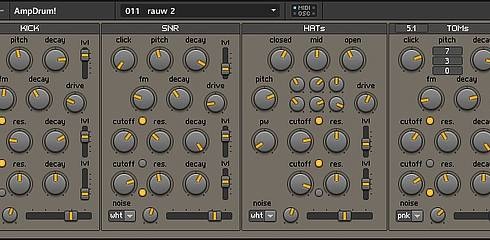
AmpDrum is basically 4 standard-808-type-VA-drum-modules with one twist:
Instead of just mixing the main signal with noise, it gets amplitude modulated (/ringmodulated) by the noise.
This produces some nice distortions and more natural sounding Analogue Drums.
Kick and snare both have 3 layers, one body and two noises, the lower noise can bypass the ringmodulator.
The hihat has two layers, one consisting of 6 detuned pulsewaves and noise,
since V1.1: Now with additional TOMs module for 3 tuned toms.
For all 4 modules you can choose the noise type at the bottom.
All modules are also connected directly to individual outputs.
V 1.2 update:
Now fully velocity sensitive and always triggering on note-on (even if no note-off is sent in between), like a drum machine should.
Big thanks to bensonreakt and mosaic_ from the forum for helping me out with the perfect solution for that!
v1.3: changed the midi-mapping for better compatibility with standard midi layout
midi-Notes:
C3 - Kick
D3 - Snare
F#3,G#3,A#3 - Hihats
F3, G3, A3 - Toms
1.4: another small bugfix for velocity setting of bypassed noise
"vel body" sets the velocity amount for amplitude in general
"vel noise" sets the velocity amount for the noise part in relation to the body
***
Carbon 4 4.05
by APH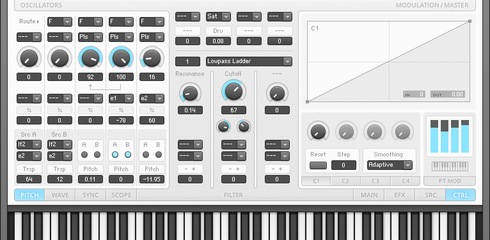
Bézier Scaler, Step Sequencer, New Interface, 170+ Snaps
This ensemble replaces my modification of Mike Daliot’s famous Carbon synthesizer. As with the last version: The name of the ensemble should not be taken too earnest ... we are still waiting for a Carbon 3 synthesizer in the Reaktor Library, isn’t it? The update is mainly directed to improving the technical features of the instrument. The new features are in detail:
(1) Cubic Bézier scaler for the macro controls with variable quantization step size and different modes for value change smoothing. The Bézier curve is defined by four control points. When the scaler is reset to identity transformation, the two off-curve points can be "drawn" out of the on-curve points at the corners of the coordinates field.
(2) Two monophonic step sequencers (with unipolar and bipolar step value assignment modes and copy, paste, clear and randomize options), synchronized to the global MIDI clock and available as modulation sources.
(3) Smaller improvements of the low frequency oscillators, different noise types in the oscillator section, self activating oscilloscope, custom parameter names for DAW automation, virtual keyboard.
(4) Streamlined user interface, with A and B view. Switch to B view (using a right click anywhere on the panel) to hide the keyboard!
The Bézier scalers were primarily designed for the use with MIDI breath controllers such as the EWI. But they are also useful in connection with other hardware. Assign the same MIDI source (such as a knob) to different macro controls, adjust the respective Bézier curves, and you will be able to change different parameters of the synthesizer in a fairly complex way by a single turn of the hand.
As the update is directed to the technical side of the instrument, the snapshot library has grown less than it is to be expected with a new upload. I know people like new snaps, so please excuse this. You will find all of my snapshots from the previous version rebuilt for the current one as well as some new snaps showing the features I was writing about. Listen to the audio files to get a first impression. By the way, when selecting snaps from the "APH Run MIDI Clock" bank, please make sure that, well, the MIDI clock is running. Quite self explaining ...
All new features are pretty well documented in the tooltips. Just hit the info button or select Cmd-I.
***
CENTIPEDE SCENARIO
by CAL Scott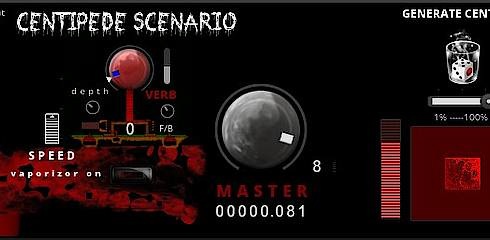
24 Voice Chaintwister Tone-Gen
Features:
- 24 Voice, 8-way Chaintwister Tone-Gen (inc Boutique)
- Stereo Feedback Comb Poly Filter
- Dual Input Selector
- A/B MODS Enhanced
- A.I. Mode + GEN-MODE
- Mutate + Liquidize
- FlameZap Verb
- Dual Crusher
- 12 Notch Vaporizor
- Random + 70 Snaps
- Guillotine Screamer
- super-cooL CPU 20%
(v1.1 updates - added LFO to random all, upgraded screamer, crusher is now dual, fixed scope, limiter and better snaps with improved levels)
(to play from a keyboard select boutique - and enable keytracking)
Centipede Scenario is a TG8 mod with loads of R5/6 user and NI parts...
***
Hydrogen 1.2
by Jake Huryn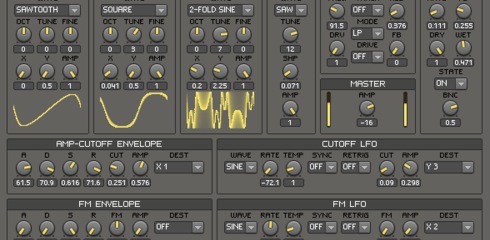
Hydrogen is an monophonic, experimental single-oscillator waveshaping synthesizer that excels at creating metallic, harmonically-rich bass sounds. The three oscillators are anti-aliased and can be selected from seventeen different waveform types, along with a simpler sub oscillator. These are then sent into a multimode filter which can range from acidic to warm to overdriven with the feedback and drive parameters. Last in the signal path is a simple stereo delay.
The modulation sources are two ADSR envelopes and two LFOs. The LFOs can be six different waveforms and are gate-retriggerable and can be tempo synced, and audio-rate modulation is also a possibility. These modulators can be routed to fifteen modulation destinations in addition to a default routing for each source. Additionally, there are a number snapshots (displayed in the audio demo) which cover some of Hydrogen's synthesis capabilities.
Certain settings create more aliasing than others, so be careful.
v1.2
• New waves - sin, saw, saw width, rectified, BLIT, ringmod
• Each oscillator can be controlled individually
• Sub oscillator
• New filter modes (bp/hp), new filter drive implementation which can be deactivated
• Tempo sync
• New modulation destinations plus default routings for each source
• Stereo delay
• Various improvements and optimizations to the synthesis and interface
v1.1
• Detunable, 3-oscillator unison
• Two AHDSR envelopes
• Two LFOs
• Modulation routing
• Interface changes
***
Kanonika
by giona francesco arturo vinti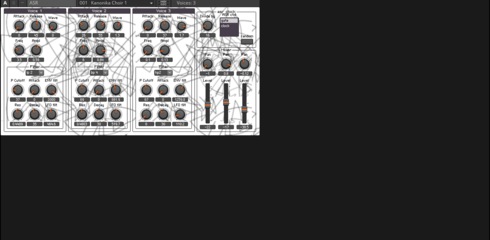
3 voice analog shift register synth
my first attempt at emulating behaviour of an analog shift register with a 3 s&h circuits cascade.
each of the three voices is a complete simple subtractive synth with some control.
Feeding it a monophonic melody it generates canon-like structures, rounds and similar stuff. Somewhat baroque-sounding...
***
test of modular x4
by Herwig Krass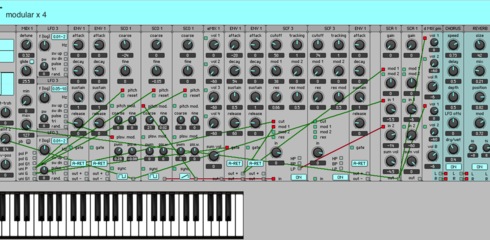
While so many users are interested on modular x i upload a preview-prehear-file.
It is only an appetizer - have fun
***
The Siegtron
by Adam Walder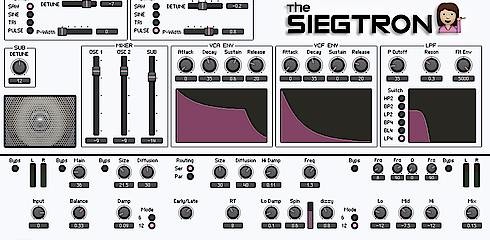
2 osc synth with sub osc and reverb
A sassy 2 osc synth with 3 octave sub osc and elements of Space Master as a reverb unit.
***
